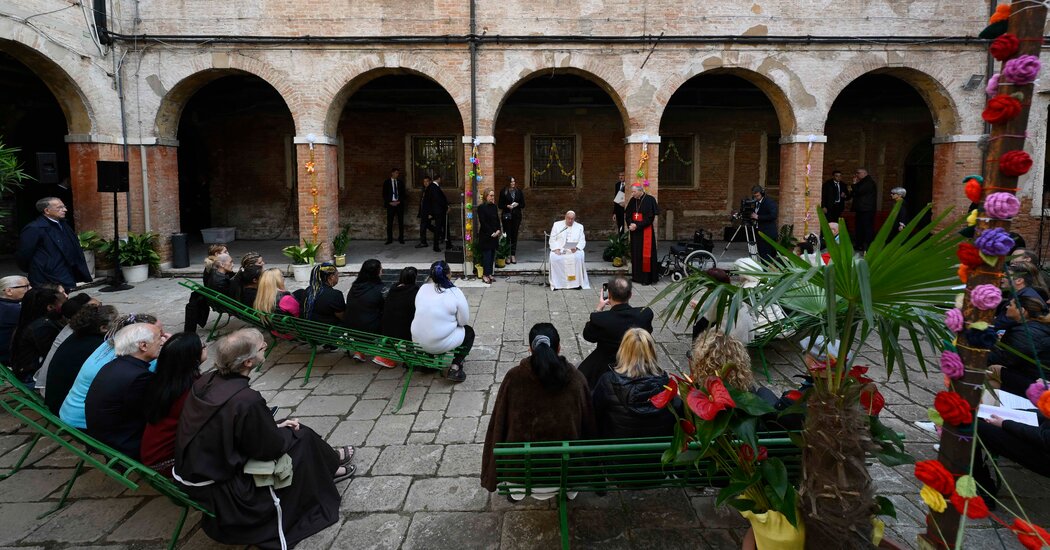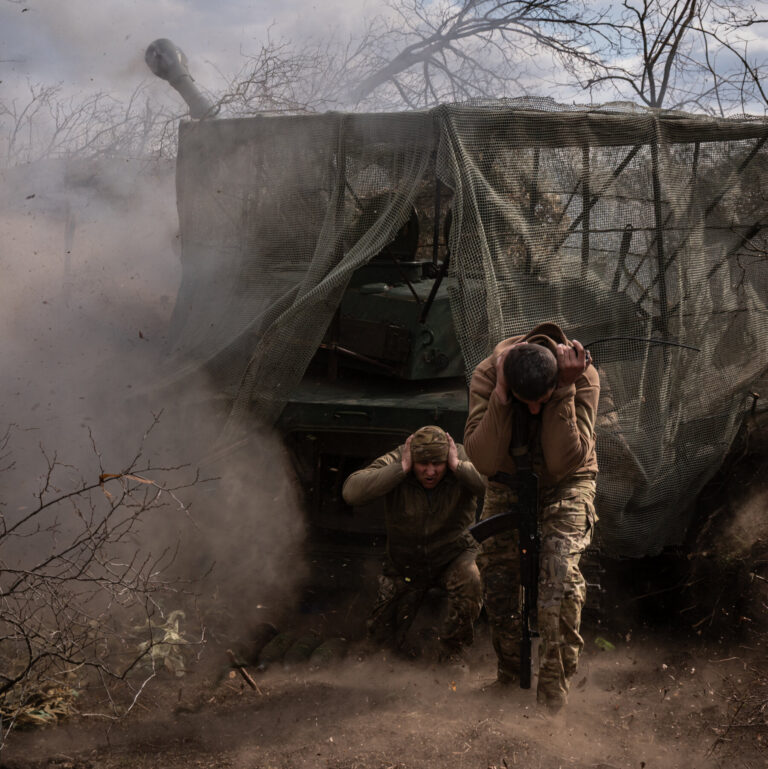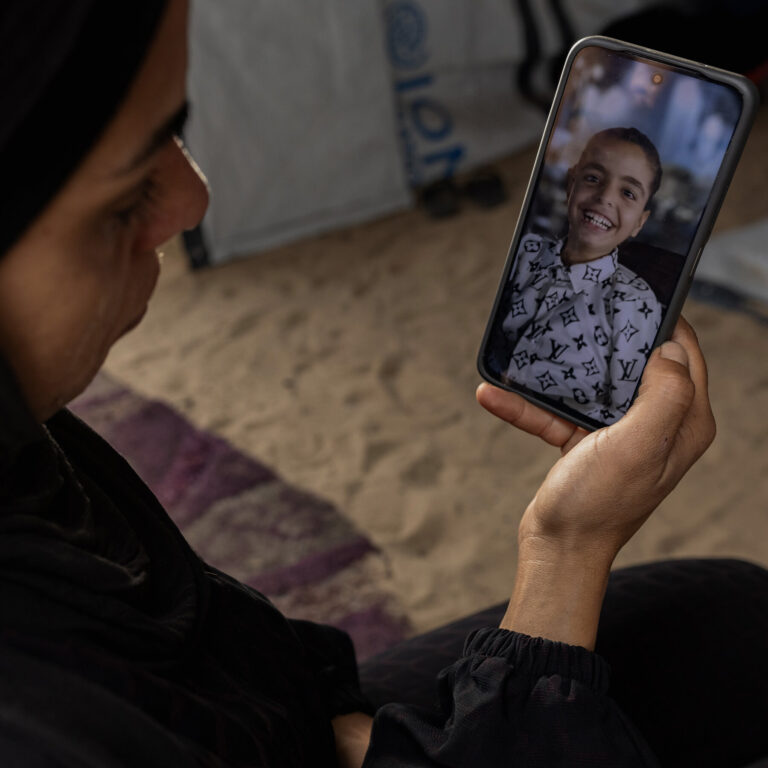Landing by helicopter at the women's prison where the Vatican has set up its pavilion for the Venice Biennale international art exhibition, Pope Francis on Sunday told the women detained there that they had a “special place in my heart.”
“Thank you,” a woman shouted. Others applauded.
Many women had participated with artists in creating works hung throughout the prison for the exhibition, titled “With My Eyes.” Francis, the first Pope to visit – albeit briefly – a Venice Biennale, stated that it is “fundamental” that the prison system “offers prisoners tools and spaces for human, spiritual, cultural and professional growth, creating the conditions for their healthy reintegration.”
“Not to isolate dignity, but to give new possibilities,” Francis said to applause.
Over the decades, countries participating in the Biennale – the world's leading showcase for new art – have used deconsecrated churches, former breweries, steamboats and various other sites to display their art, but this was the first time it a prison was chosen.
This made the project “more complex and more difficult to carry out,” Bruno Racine, director of two branches of the Pinault Collection in Venice and co-curator of the Vatican Pavilion, said in an interview. But the context is consistent with Francis' message of inclusiveness towards marginalized people, he added.
The Vatican project has received extremely positive public reception, but has not been without controversy. Some critics have raised ethical concerns about the intersection between powerful institutions like the Vatican and the Biennale and the limited autonomy of women prisoners. Others have suggested that the Vatican, in organizing the show, was complicit in a penal system in which overcrowding remains a serious problem.
Still others called for the pope to seek clemency or at least a reduced sentence for women imprisoned because they responded violently to domestic abuse.
“I don't think the Vatican has the power to have any influence on Italian justice,” Racine said of this idea.
Although the Vatican has not responded publicly to the criticism, Francis has consistently been outspoken about domestic abuse, saying in 2021 that there was something “almost satanic” about the high number of cases of domestic violence against women.
He was also a strong advocate for prison reform, denouncing overcrowding and frequently meeting prisoners on his travels.
On Sunday, Francis said that prison is “a harsh reality, and problems such as overcrowding, lack of facilities and resources, and episodes of violence cause much suffering there.” But he said prison could also be a place where people's dignity could be “promoted through mutual respect and the cultivation of talents and abilities, perhaps dormant or imprisoned by the vicissitudes of life.”
The Pope described his artistic vision to the artists he called to the Sistine Chapel last year, telling them to “think of the poor and ensure that art goes to the periphery”, the Vatican's culture chief previously said , Cardinal José Tolentino de Mendonça. year. Francis told artists involved in the Vatican project on Sunday that “the world needs artists.”
The curators, Racine and Chiara Parisi, of the Center Pompidou-Metz, the French museum, selected a handful of artists to work with the incarcerated women to create works scattered around the prison.
One, a 1965 silkscreen with the word Hope backwards, hung above the door of the prison cafeteria, where about a quarter of the more than 80 inmates who agreed to lead the exhibit first meet visitors. The screenprint was created by the artist Corita Kent, a former nun and social justice activist who died in 1986.
Lebanese artist Simone Fattal transcribed poems and reflections of incarcerated women onto slabs of lava lining a brick corridor: “I thought I was suffocating.” “I often think about my family.” “I'm so sad.”
In another room were small stylized paintings by French artist Claire Tabouret based on family photos the women had given her.
Visitors get only a brief glimpse of penitentiary life, but during the tour a short film, directed by Marco Perego and starring his wife, actress Zoe Saldaña, shows the conditions inside in bleak black and white: shared rooms, shared showers, little privacy. Both inmates and professional actresses starred in the film, Mr. Racine said.
This is the third time that the Vatican has participated in the Biennale: in 2013 and 2015 it was among the many participants at the Arsenale, one of the main venues of the fair. And for the 2018 Architecture Biennale, the Vatican built a series of chapels, “for believers and non-believers,” which can still be visited.
On Sunday the pope greeted the inmates of the Giudecca prison individually in an internal courtyard. Some gave him flowers, others held envelopes and cards in their hands.
Giovanni Russo, head of the Department of Penitentiary Administration at Italy's Justice Ministry, told reporters at a Vatican press conference in March that women who participated in the project were entitled to unspecified benefits. Although the Vatican Pavilion was unique, he said, nearly all of Italy's 190 penitentiaries had “art projects” of one kind or another, involving more than 20,000 volunteers.
It is not the first time that prison inmates have participated in large artistic projects. Two years ago, French artist Pauline Curnier Jardin worked with inmates to make a film and paint a large common room where the women meet visitors twice a week. The walls are now a pale purple, decorated with stylized leaves and figures drawn by inmates during a series of workshops with the artist.
After the Biennial closes in November, the “With My Eyes” artwork will be removed, Racine said. But Ms. Curnier Jardin's calming additions will remain.
After prison, Pope Francis celebrated Mass in St. Mark's Square.
Praising the “enchanting beauty” of Venice during the homily, he added that the city is also threatened by issues such as climate change, excessive tourism and the “fragility of buildings, of cultural heritage, but also of people”, which risk wearing out the social society of the city. tissue. City authorities this week began charging an entry fee into the city, hoping to discourage day visitors from arriving on particularly busy days.
Many tourists hoping to visit St. Mark's Square on Sunday were hampered by dozens of blockades around the area, part of increased security measures for the pontiff's visit.
“I'm not angry,” said Julia Suh, visiting from Augusta, Georgia, on one of the blocks as she watched the Mass on her cellphone. “I'm very honored: it's what they should do because of the increased security.”





